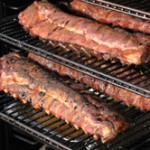 Outdoor smokers are a popular meat preparation method for several reasons. For one, the smoky taste of these meats has been adopted as an art form by many backyard chefs. The long cooking times at low temperatures are also great for lazy days cooking outside, making smoking a great reason for social gatherings as well.
Outdoor smokers are a popular meat preparation method for several reasons. For one, the smoky taste of these meats has been adopted as an art form by many backyard chefs. The long cooking times at low temperatures are also great for lazy days cooking outside, making smoking a great reason for social gatherings as well.
But smoking meat isn’t nearly as easy as grilling or other methods of meat preparation. There are plenty of things that can go wrong, and if you don’t properly season the meat, it could come out dry and unsatisfying.
Smoking also calls for a lot of extra ingredients and supplies, so the up-front cost — beyond the purchase of the smoker itself — can be a little high. See if you can find starter sets or online coupons to defray the costs of some of these items.
Whether you’re smoking pork, beef, chicken or other meats, the method of preparation tends to be somewhat similar. Follow this rough road map to effective smoking to make sure you impress your guests on your first try.
Start the night before
If you want a great flavor in your smoked meats, you need to marinate the meat. The smoke flavor and external seasonings will be a great complement, but marinating meat will make it much more flavorful in every bite. Whether you apply a dry rub or wet rub, do so the night before and left the meat marinate overnight in your refrigerator.
Getting the conditions right
To a large extent, the end result of your smoked meats depends on the conditions of the smoker when the meat is placed inside. You need to make sure that the temperature is stabilized to guarantee a proper cooking process. Most smokers begin with charcoal to start the fire and get the temperature high. Once the charcoal fire has burned down, wet wood should be added into the smoker.
Use the smoker’s vents to trap heat or let it escape, and continue tinkering until the temperature has stabilized between 225 and 250 degrees Fahrenheit. At that point, you can place the meat inside the smoker. If your smoker uses a water tray, make sure that is filled — and add some seasonings to the water, if you’d like. The steam can help infuse the meat with flavor.
The passive cooking process
Even though you don’t do much while your meats are smoking, you still need to be in the vicinity of the smoker and checking on the temperature periodically. If the temperature falls out of the 225-250 degree range, your meat won’t smoke properly. Depending on the size of the smoker, you may have to add extra charcoal or wood to maintain that temperature after several hours have passed. Always keep extra fuel on hand in case the temperature continues to drop no matter what you do.
The final seasoning
Within the last 30 minutes of cooking, add one more layer of barbecue or other seasoning sauce. This will give the sauce enough time to caramelize and crisp, and the finish on your meats will be mouth-watering good.
As you become more familiar with the smoking process, you may incorporate your own signature seasonings or other preparation methods. You might even come to trade tips and tricks with fellow smokers. There’s a reason good barbecue and smoked meats are in high demand — it’s hard for amateurs to recreate, but great smoked meats are tough to beat!

